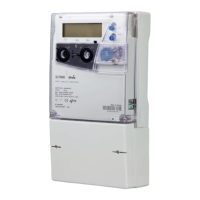28
Pulse input
The meter can be factory-configured with a number of optically-isolated pulse inputs for connection to further DIN
S0 meters or other pulse output devices that are compliant with IEC 62053-31.
Received pulses are recorded in separate external-energy registers as total pulse counts and can represent
metered energy types such as electricity, water or gas as either import or export energy values. Depending on
the meter configuration, these external-energy register values can be included in the metering data in a number
of ways.
Pulse input terminals
The pulse input terminal block provides a common connection point and accepts cables up to 1.5mm².
Maximum input voltage (provided by the meter) = 27V DC
Maximum current = 30mA
Impedance = 1.1kΩ
Terminal Function Typical wiring
36 Pulse input 1
37 Pulse input 2
38 Pulse input 3
39 Pulse input 4
40 Common
Note: Depending on the factory configuration, the meter may not be fitted with Pulse inputs 3 and 4.
Pulse output
The meter can be factory-configured with a number of optically-isolated pulse outputs for connection to further
DIN S0 meters or other pulse input devices that are compliant with IEC 62053-31.
Pulse output characteristics such as duration and frequency can be individually programmed and each output
can be assigned to represent a configurable quantity of either import or export metered energy.
Pulse outputs can be redirected to Control outputs and can also be configured to provide a metrological output
(when the LED flashes a pulse is sent).
Pulse output terminals
The pulse output terminal block provides a common connection point and accepts cables up to 1.5mm².
Maximum output voltage = 27V DC
Impedance < 300Ω
Terminal Function Typical wiring
29 Pulse output 1
30 Pulse output 2
31 Pulse output 3
32 Pulse output 4
33 Pulse output 5
34 Pulse output 6
35 Common

